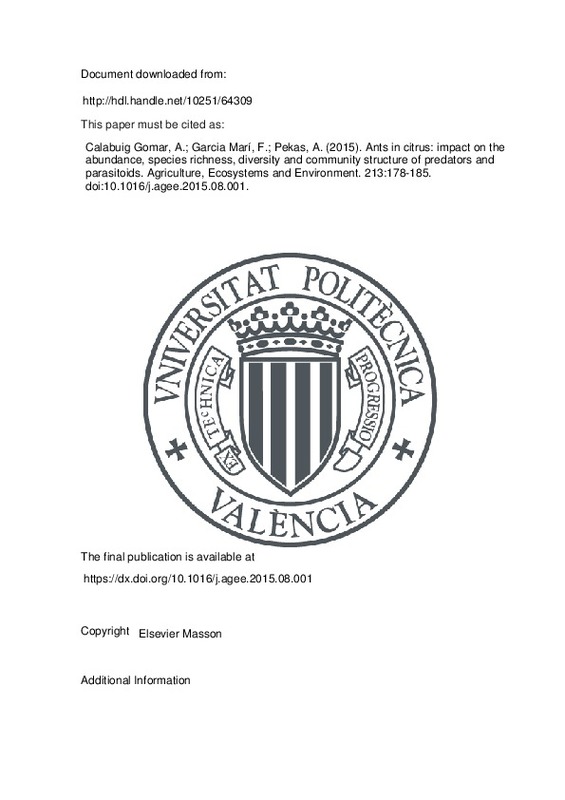JavaScript is disabled for your browser. Some features of this site may not work without it.
Buscar en RiuNet
Listar
Mi cuenta
Estadísticas
Ayuda RiuNet
Admin. UPV
Ants in citrus: impact on the abundance, species richness, diversity and community structure of predators and parasitoids
Mostrar el registro sencillo del ítem
Ficheros en el ítem
| dc.contributor.author | Calabuig Gomar, Altea
|
es_ES |
| dc.contributor.author | García Mari, Ferran
|
es_ES |
| dc.contributor.author | Pekas, Apostolos
|
es_ES |
| dc.date.accessioned | 2016-05-18T11:00:36Z | |
| dc.date.available | 2016-05-18T11:00:36Z | |
| dc.date.issued | 2015-12-25 | |
| dc.identifier.issn | 0167-8809 | |
| dc.identifier.uri | http://hdl.handle.net/10251/64309 | |
| dc.description.abstract | [EN] Although ants act as plant biotic defences, in agricultural ecosystems they are often associated with outbreaks of honeydew-producing pests mainly due to the protection they offer to the plant feeders in exchange for honeydew. In such an interaction ants may alter the abundance, diversity and community structure of predators and parasitoids. In the present study, we conducted ant-exclusion experiments in three commercial citrus orchards, each one dominated by one ant species (Pheidole pallidula, Lasius grandis or Linepithema humile) during two consecutive years (2011 and 2012). We then compared the abundance, species richness, diversity and community structure of predators and parasitoids between the ant-allowed and ant-excluded treatments. A total of 176,000 arthropods belonging to 81 taxa were captured and identified. Regarding abundance, our results showed a species specific response between treatments. When examining functional groups, in the ant-allowed treatment, seven species of predators decreased and four increased in abundance, whereas four species of parasitoids decreased and 18 increased in abundance. The species richness (S) was significantly lower for predators and higher for parasitoids in the ant-allowed treatment. The Shannon diversity index (H) was not different between treatments in the case of predators, whereas in the case of parasitoids diversity was significantly higher in the ant-allowed treatment. Finally, the community structure of predators and parasitoids was not significantly different between treatments. These results suggest that ants in the citrus agroecosystem are not associated with a dramatic decrease in natural enemy abundance or biodiversity; on the contrary ants were associated with increased parasitoid species richness and diversity. Despite the fact that ants have no negative impact on the abundance and diversity of predators and parasitoids at the community level their impact on specific natural enemy species, mainly predators, may explain the highest pest densities associated with ants in citrus. | es_ES |
| dc.description.sponsorship | This work was supported by the project (RTA2010-00012-C02-02) assigned to F.G.M. from the Instituto Nacional de Investigacion y Tecnologia Agraria y Alimentaria (INIA) of Spain. We thank Alejandro Tena for his comments that improved the manuscript. | en_EN |
| dc.language | Inglés | es_ES |
| dc.publisher | Elsevier Masson | es_ES |
| dc.relation.ispartof | Agriculture, Ecosystems and Environment | es_ES |
| dc.rights | Reserva de todos los derechos | es_ES |
| dc.subject | Ants | es_ES |
| dc.subject | Citrus | es_ES |
| dc.subject | Biodiversity | es_ES |
| dc.subject | Community structure, parasitoids | es_ES |
| dc.subject | Predators | es_ES |
| dc.subject | Natural enemies | es_ES |
| dc.subject.classification | PRODUCCION VEGETAL | es_ES |
| dc.title | Ants in citrus: impact on the abundance, species richness, diversity and community structure of predators and parasitoids | es_ES |
| dc.type | Artículo | es_ES |
| dc.identifier.doi | 10.1016/j.agee.2015.08.001 | |
| dc.relation.projectID | info:eu-repo/grantAgreement/MICINN//RTA2010-00012-C02-02/ES/Influencia de las hormigas en las poblaciones de artrópodos fitófagos y sus enemigos naturales en parcelas de cítricos/ | es_ES |
| dc.rights.accessRights | Abierto | es_ES |
| dc.contributor.affiliation | Universitat Politècnica de València. Departamento de Ecosistemas Agroforestales - Departament d'Ecosistemes Agroforestals | es_ES |
| dc.description.bibliographicCitation | Calabuig Gomar, A.; García Mari, F.; Pekas, A. (2015). Ants in citrus: impact on the abundance, species richness, diversity and community structure of predators and parasitoids. Agriculture, Ecosystems and Environment. 213:178-185. https://doi.org/10.1016/j.agee.2015.08.001 | es_ES |
| dc.description.accrualMethod | S | es_ES |
| dc.relation.publisherversion | https://dx.doi.org/10.1016/j.agee.2015.08.001 | es_ES |
| dc.description.upvformatpinicio | 178 | es_ES |
| dc.description.upvformatpfin | 185 | es_ES |
| dc.type.version | info:eu-repo/semantics/publishedVersion | es_ES |
| dc.description.volume | 213 | es_ES |
| dc.relation.senia | 301823 | es_ES |
| dc.identifier.eissn | 1873-2305 | |
| dc.contributor.funder | Ministerio de Ciencia e Innovación | es_ES |







![[Cerrado]](/themes/UPV/images/candado.png)

